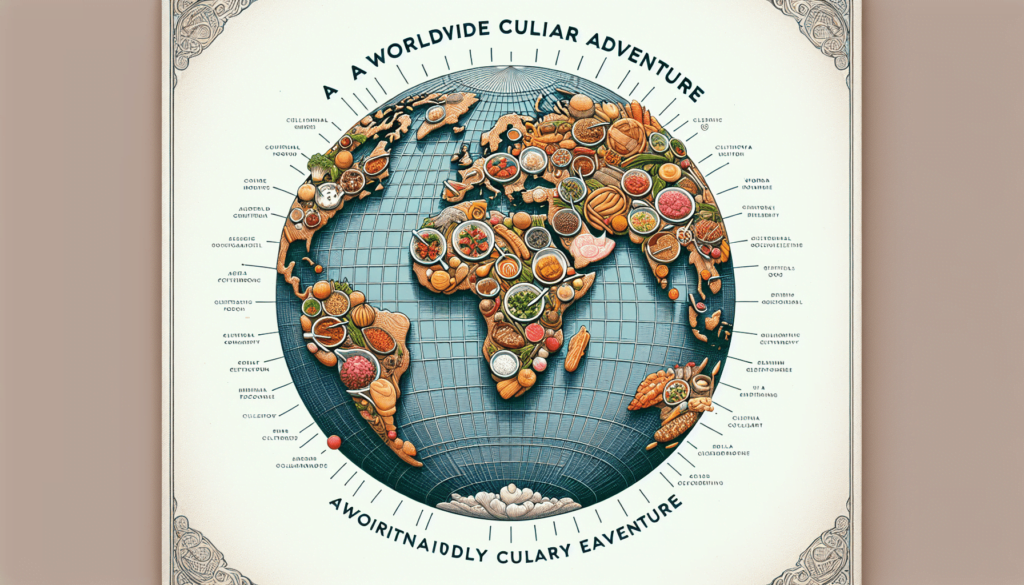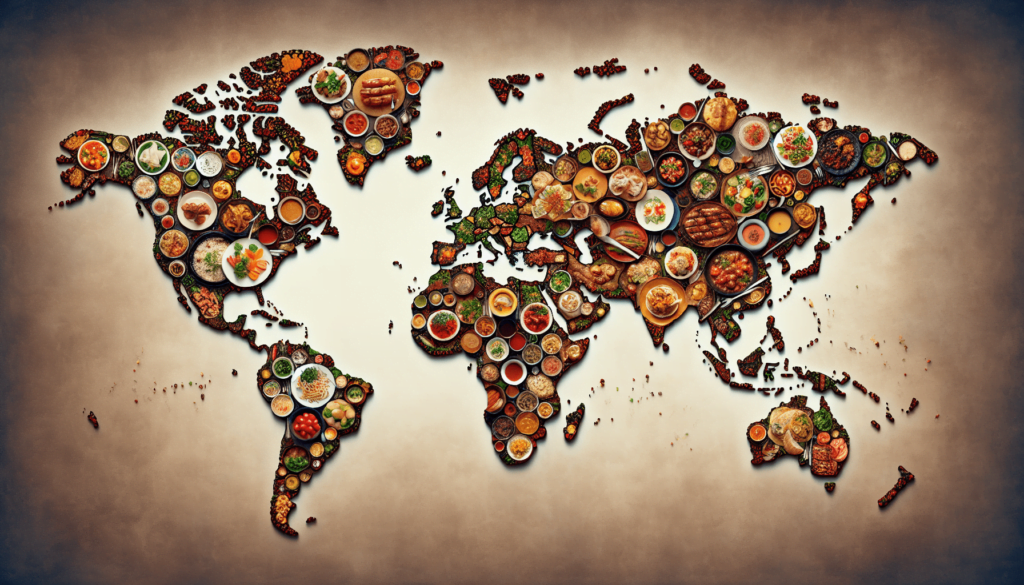A Food Lover’s Travel Diary: Savoring Culinary Delights Around the World” invites you on a mouth-watering journey through the rich tapestry of global cuisines. From the spicy streets of Bangkok to the pastry-laden boulevards of Paris, you are transported into a world where every bite tells a story. This diary captures the essence of each destination, blending historical context with current trends, while exploring key concepts and detailed subtopics to provide a thorough understanding of what makes each cuisine uniquely delightful. Through captivating examples and balanced perspectives, you’re given a front-row seat to the diversity of global culinary practices.
Looking ahead, the diary offers insightful predictions on upcoming food trends and discusses the broader cultural implications of these gastronomic discoveries. It’s a delectable read that not only satisfies your culinary curiosity but also leaves you eager to embark on your own flavor-filled adventure. Have you ever dreamt of traveling the world, savoring a country’s essence through its culinary delights? Whether you’re uncovering the secrets of an Italian kitchen or enjoying the vibrant flavors of Thai street food, food has an uncanny way of connecting us to a place, its culture, and its people. Welcome to “A Food Lover’s Travel Diary: Savoring Culinary Delights Around the World,” where each meal is a story waiting to be told.

Table of Contents
Overview
The world is an expansive buffet brimming with flavors, textures, and aromas that define each locale’s unique culture. Food is essential not just for sustenance but as a powerful lens to understand societies, traditions, and histories. As we delve into different cuisines from around the globe, we’ll uncover the rich tapestry of stories, people, and places that make each bite memorable.
Thesis Statement
In “A Food Lover’s Travel Diary: Savoring Culinary Delights Around the World,” we argue that exploring global cuisines allows for a nuanced understanding of cultural identities, historical influences, and current culinary trends, offering a rich, immersive travel experience.
Historical Context
Before diving into today’s global culinary scene, it’s worth appreciating how historical context shapes a region’s food heritage. Each dish tells a tale of trade routes, conquests, migrations, and innovations. Consider the vibrant paella from Spain, a dish deeply rooted in Valencia. Its origins trace back to the Moors, whose influence brought rice into the region. Similarly, the spices in Indian curry harken back to bustling ancient trade routes that connected East and West.
Secondary Keywords: Culinary Heritage, Trade Routes, Origin of Dishes
Understanding these historical confluences enriches our culinary journey, providing a backdrop against which modern dishes can be appreciated.
Savoring Culinary Delights Around the World
Current Trends
Modern culinary trends are a fascinating reflection of our globalized world. From farm-to-table movements to molecular gastronomy, our relationship with food is continually evolving. Currently, there’s a growing emphasis on sustainable and locally-sourced ingredients, mirroring a broader societal push towards environmental stewardship.
Relevant Keywords: Modern Culinary Trends, Sustainable Food, Globalized Cuisine
Global culinary trends are not just about the latest Instagram-worthy dish; they represent significant shifts in how we approach, appreciate, and consume food.
Key Concepts and Definitions
To navigate this culinary journey, let’s establish some key concepts:
- Farm-to-Table: A movement prioritizing locally-sourced, sustainable ingredients to minimize environmental impact and promote local economies.
- Molecular Gastronomy: A sub-discipline of food science that seeks to transform traditional cooking through technological innovations.
- Fusion Cuisine: The integration of elements from different culinary traditions to create innovative, hybrid dishes.
Related Keywords: Culinary Terminology, Food Science, Fusion Cuisine
Having a grasp of these terms will enhance your understanding and appreciation of contemporary culinary practices.

Detailed Exploration
Europe: A Symphony of Flavors
Europe, a continent with a complex history of kingdoms, wars, and migrations, boasts an incredibly diverse culinary landscape. Imagine biting into a buttery croissant on a Parisian morning or savoring a hearty goulash in the streets of Budapest. Each dish offers a glimpse into the history and culture of its region.
Example 1: Italy
Italy’s cuisine, renowned for its simplicity and reliance on high-quality ingredients, varies significantly from region to region. Northern Italy, known for its creamy risottos and rich polentas, contrasts starkly with the tomato-based dishes of the South. When in Italy, savoring a plate of pasta alla carbonara in a Roman trattoria is more than a meal; it’s a cultural experience.
Asia: The Melting Pot of Flavors
Asia’s vast expanse and diverse cultures contribute to a culinary scene that’s as varied as it is flavorful. Whether you’re enjoying sushi in Tokyo or exploring the intricate flavors of Indian curry, Asian cuisine offers a spectrum of tastes that can range from the explosive heat of Sichuan peppercorns to the delicate sweetness of coconut milk.
Example 2: Thailand
Thai cuisine, known for its balance of sweet, sour, salty, and spicy flavors, is a must-experience for any food lover. Sampling street food in Bangkok, from pad thai to mango sticky rice, you’ll uncover the layers of flavors and ingredients intrinsic to this vibrant cuisine.
Americas: A Tapestry of Culinary Traditions
North and South America offer a mix of indigenous and immigrant culinary influences. The sweet, smoky BBQ flavors of Texas, the fresh, citrusy ceviche of Peru, and the hearty poutine from Canada—all these dishes tell a story of cultural melding and innovation.
Example 3: Peru
Peruvian cuisine is a fascinating fusion of indigenous ingredients and techniques with influences from Spanish, African, and Chinese cuisines. Ceviche, Peru’s national dish, is a must-try that beautifully encapsulates this culinary amalgamation.
Africa: A Hidden Gem of Culinary Richness
Africa’s culinary offerings are often overlooked but are filled with depth and variety. From the savory stews of West Africa to the aromatic spices of North Africa, the continent offers a rich palette of flavors waiting to be explored.
Example 4: Morocco
In Morocco, the traditional tagine—a slow-cooked stew named after the earthenware pot in which it’s cooked—represents a blend of Berber, Arab, and Mediterranean influences. The complex interplay of spices like saffron, cinnamon, and cumin in dishes like lamb tagine is a revelation.
Comparison of Different Perspectives
Exploring global cuisines also means encountering diverse perspectives on dining and food preparation. For instance, while French cuisine emphasizes meticulous technique and presentation, Japanese cuisine values simplicity and the freshness of raw ingredients. The differences in culinary philosophies can offer deeper insights into cultural values and societal structures.
Table: Culinary Philosophies Across Cultures
| Region | Philosophy | Example |
|---|---|---|
| France | Technique and Presentation | Coq au Vin |
| Japan | Simplicity and Freshness | Sushi |
| Italy | Quality of Ingredients | Margherita Pizza |
| India | Spices and Complexity of Flavors | Butter Chicken (Murgh Makhani) |
Impact Assessment
The contrasting philosophies not only highlight different cultural approaches but also influence the global culinary scene. French techniques, such as the mother sauces, serve as foundation blocks in Western kitchens, while the Japanese principle of minimalism impacts modern dining trends globally. These philosophies contribute to a richer, more diversified food culture worldwide.
Future Directions and Implications
So, where do we go from here? Culinary trends are ever-evolving, heavily influenced by socio-economic factors, technological advancements, and changing consumer preferences. As people become increasingly health-conscious and environmentally aware, sustainable food practices are likely to dominate the future culinary landscape.
Predictions
We can anticipate a surge in plant-based diets, as well as greater innovation in food technology, such as lab-grown meat and blockchain for food traceability. This evolution will not only affect what’s on our plates but also how we source, prepare, and think about food.
Implications
The implications of these developments are far-reaching. For the food industry, this means investing in sustainable practices and innovative technologies. For society at large, it reinforces the importance of making informed, ethical food choices that promote health and sustainability.
Conclusion
Recap
In “A Food Lover’s Travel Diary: Savoring Culinary Delights Around the World,” we journeyed through the rich and varied landscapes of global cuisines, uncovering the historical, cultural, and modern influences that shape each dish. From Europe’s meticulous culinary traditions to Asia’s vibrant street food culture, and from the Americas’ fusion of flavors to Africa’s hidden culinary gems, we explored how food connects us to places and their stories.
Final Thought
Next time you sit down for a meal, whether it’s a simple homemade supper or a dish from a far-flung locale, think about the cultural connections and histories that brought it to your table. Each bite is a journey, a story waiting to be discovered.
We’d love to hear about your own culinary adventures! Share your experiences or favorite international dishes in the comments below. And if you enjoyed this article, please share it with fellow food lovers eager to explore the world, one bite at a time.
Credible Sources
Below are some of the sources and further reading materials referenced in this article:
- “A History of Food” by Maguelonne Toussaint-Samat – A comprehensive look into the history and cultural significance of food.
- “On Food and Cooking: The Science and Lore of the Kitchen” by Harold McGee – An insightful guide into the science behind cooking techniques.
- “The Food Lab: Better Home Cooking Through Science” by J. Kenji López-Alt – A resource for understanding modern culinary techniques and trends.
- National Geographic Food Journeys of a Lifetime: 500 Extraordinary Places to Eat Around the Globe – A visual and gastronomic tour of the world’s best culinary experiences.
Embark on your culinary journey, savoring each flavor, and let every dish tell you a story. Bon appétit! 🍽️
Taste the World: A Gastronomic Journey for the Culinary Enthusiast
